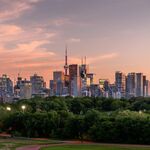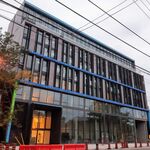You are using an out of date browser. It may not display this or other websites correctly.
You should upgrade or use an alternative browser.
You should upgrade or use an alternative browser.
Mississauga: Ninth Line Lands redevelopment
- Thread starter Jasonzed
- Start date
…and if you're starting afresh, why wouldn't you properly protect the bike lanes? Argh!What streets are they portraying there? Are they suggesting Ninth Line will be anything other than a traffic gutter?
For anyone interested, materials are available here:
Shaping Ninth Line
www.mississauga.ca
42
afransen
Senior Member
They don't know what they don't know. It's bike lanes as fashion statement.…and if you're starting afresh, why wouldn't you properly protect the bike lanes? Argh!
42
NY99
Active Member
I don't get why they won't allow at-grade retail along the entirety of Ninth Line
I appreciate that they're trying to apply 15-minute city principles, but it seems like they're missing the mark tbh
I appreciate that they're trying to apply 15-minute city principles, but it seems like they're missing the mark tbh
Divas S.
Active Member
The 407 Transitway runs by the project so someday in 2100 they will have rapid transit accessStill not ideal, as this is incredibly car-oriented. What we really need is to make complete communities. The real shame is that we didn't take the opportunity to build TOD complete communities around GO stations (like streetcar suburbs), and forgot to reserve ROWs for regional rail to make more of them.
Big Daddy
Senior Member
As this is the last undeveloped remnant of the city of Mississauga, I think its high tilme the city look into annexing land from Halton.

afransen
Senior Member
Why would Mississauga need to annex? Milton can develop that just as well.
I think it would be a neat idea to drop a new GO station on the Milton line (ownership issues notwithstanding) between Milton and Lisgar stations, and use it as the hub of some transit oriented low-car greenfield developments. Maybe even create a spur heading south off the Milton line running parallel between Eighth Line and Trafalgar and west between Milton and the 407. Much of this land is planned for greenfield development. It would be great if we did it in a more transit-oriented way, with GO RER service forming the backbone (hopefully also getting the upgrade to Milton line through Mississauga.
Something like Houten, but it could support perhaps more midrise to help compensate for the larger unit expectations we can have Canada
I think it would be a neat idea to drop a new GO station on the Milton line (ownership issues notwithstanding) between Milton and Lisgar stations, and use it as the hub of some transit oriented low-car greenfield developments. Maybe even create a spur heading south off the Milton line running parallel between Eighth Line and Trafalgar and west between Milton and the 407. Much of this land is planned for greenfield development. It would be great if we did it in a more transit-oriented way, with GO RER service forming the backbone (hopefully also getting the upgrade to Milton line through Mississauga.
Something like Houten, but it could support perhaps more midrise to help compensate for the larger unit expectations we can have Canada
That's some 19th century thinking! Expand forever into farmland!As this is the last undeveloped remnant of the city of Mississauga, I think its high tilme the city look into annexing land from Halton.
View attachment 295176
42
afransen
Senior Member
That's some 19th century thinking! Expand forever into farmland!
42
Either way, this land is planned to be developed. It's only a matter of what form the greenfield development is going to take.
WislaHD
Superstar
On a serious note, it's such a shame we didn't build the yellow belt in this way to begin with (townhouses and low rise apartments). We could have had so much more housing stock and room for parks/rec/green space. I think we will forever regret this.
Well, a lot of the Toronto Yellowbelt is actually in neighbourhoods that were built for transit (streetcar suburbs or built around the early bus routes) and could successfully densify should the opportunity to do so be granted.
The real shame is that all of residential low-rise Mississauga and Brampton was not built in this manner.
In fairness, if there is any part of the 905 greenfields that should be expanded onto, it's probably the land adjacent to the highway that isn't far away from existing utility and community servicing.That's some 19th century thinking! Expand forever into farmland!
42
For me, the question is more so whether we have learned anything at all from the past that could be implemented to building sustainable communities for the future, or just continue down our path of urban sprawl.
cd concept
Senior Member
I didn't even know Mississauga own all this property. Why is it shown as Milton and Oakville owning it on the map?
NY99
Active Member
That's some 19th century thinking! Expand forever into farmland!
42
I disagree that urban expansion is inherently a bad thing. Especially when it's in an area like this -- sandwiched between a number of built-up areas, with numerous transit and utility corridors in the vicinity. It's not gonna become Rouge Park 2.0, and I can't imagine the soil quality is all that great anyway (not sure how productive the land is for farming/rural uses... would anyone know?)
My thought is this: why not apply principles of sustainability,/walkability/transit-friendliness/lax zoning/whatever and build up this land prudently? Creating a smarter development model for the suburbs would ultimately do more good for the environment, in my opinion, than letting this site go essentially unused. Not to mention we could build an absolute metric f*ckton of housing with a tiny fraction of the NIMBYism...
Last edited:
The bit that @Big Daddy is referring to is the strip between Ninth Line and the 407 as being the last unbuilt-up "remnant" of Mississauga. That part is Mississauga now (it used to be part of Milton). The rest, the area that he outlined in red, is not owned by Mississauga, it is Milton and Oakville. He's saying (for some unknown reason) that Mississauga should have it.I didn't even know Mississauga own all this property. Why is it shown as Milton and Oakville owning it on the map?
Meanwhile, Oakville is expanding its urban area north of Dundas up towards Burnhamthorpe (showing up as Regional Road 27 on the map).
If we have to continue to plough under farmland, it would make more sense to lay it out along the south side of the 401, through which a GO line already runs, and which could have one more station added to it that could become the centre of a new, transit-oriented town centre. East Milton Staton and New Town, anyone?In fairness, if there is any part of the 905 greenfields that should be expanded onto, it's probably the land adjacent to the highway that isn't far away from existing utility and community servicing.
For me, the question is more so whether we have learned anything at all from the past that could be implemented to building sustainable communities for the future, or just continue down our path of urban sprawl.
42
afransen
Senior Member
I think this is a good idea, rather than just copying the sprawl in Mississauga and Milton. I think there is an opportunity to reserve an at-grade rail ROW for GO 'RER' service running south down that strip. We should be able to do this pretty cost effectively ($20-30M per km or less without electrification) if we do it now before it starts to be built up.If we have to continue to plough under farmland, it would make more sense to lay it out along the south side of the 401, through which a GO line already runs, and which could have one more station added to it that could become the centre of a new, transit-oriented town centre. East Milton Staton and New Town, anyone?
First preference is to intensify the existing built up area, obviously. But if we are doing more large scale greenfield development (and it is in all the regional planning), we should be trying to make it as TOD as possible. We really should try to do this intelligently, when it comes to surface/regional rail provision while it is cheap to do so. We don't need to limit ourselves to legacy rail ROWs--we can take spurs off those lines.
Big Daddy
Senior Member
Up isn't the only solution. there are low rise and townhouse options as well but the city is out of land. What is your "20th century" solution?That's some 19th century thinking! Expand forever into farmland!
42




